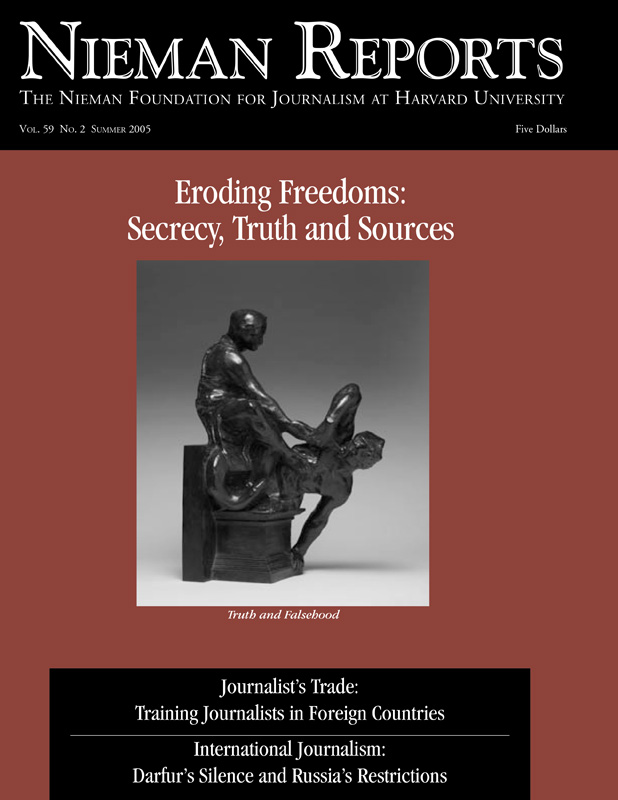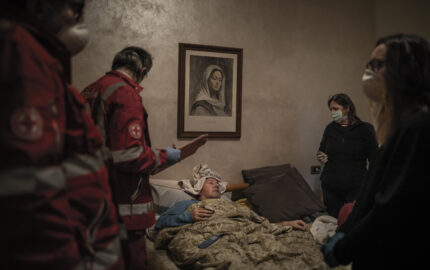
My colleagues in bureaus around Africa were equally stung by increasingly forceful declarations from humanitarian agency chiefs that Darfur was a full-blown crisis the world was overlooking. So we launched into standard-operating procedure for coverage of remote regions of Africa—we lined up transport, in this case via aid flights with the World Food Program; marshaled our best case for covering, and stepped-up our pestering of bosses to go.
Arab tribal militias, backed by Sudanese troops and warplanes, were then more than a year into an allegedly systematic campaign of emptying villages in Darfur of their non-Arab residents. More than 100,000 villagers had fled across the border into Chad. More than one million were already displaced in Darfur. Up to one-third of that million could die from disease and hunger alone in coming months, U.S. AID said. It called Darfur the world’s biggest humanitarian crisis.
It was a conflict whose basic components were compelling and easy enough for all to understand. We already had been watching the story develop for more than a year. It was now, without a doubt, the biggest spot news in Africa.
Our bosses? First response: No. We half-expected that—there was a war on, in Iraq, after all. In second and third tries and beyond, though, the answer was still no. So was what sounded like the final answer: Our organization didn’t have the resources available to spare a staff writer for Darfur. The editors would study it. In the meantime, we should concentrate on covering it as best we could with stringers.
African News Coverage
United States coverage of Africa was turning a corner. The cold war days when Africa news would command headlines among the top stories for months and years at a time, as African proxies of the East and West did battle in Africa, seemed over. They probably had been since Zaire in the 1990’s.
I came to Africa at the tail end of that time, in 1999, during the first-ever coup in the long-stable West African nation of Côte D’Ivoire, when editors still would issue a command for coverage when troops closed the land borders: “Charter.” That is to say, charter a plane if you have to, just get there, quick.
During most of my time since, American attention to Africa ebbed enough that assignments generally required preliminary rounds of drawing editors’ attention to a topic. We would talk over whether coverage was important enough and safe enough. If those two factors were there, my bosses would almost always agree. It worked for Liberia, in summer 2003, when my news organization kept American staffers in the country to aid our very good Liberian correspondent in covering the bloody last days of Charles Taylor, a cold war-era warlord. Taylor had used his country, which was founded and then largely forgotten by Americans, to stir conflicts in West Africa for nearly 15 years. We, by then joined by a lot of other Western journalists, were there for the end in August, when West African peace troops arrived to secure the capital, U.S. warships shoved into view on the horizon, and West Africa’s biggest troublemaker fled into exile.
Events across the Atlantic on September 11, 2001, helped make that kind of coverage more and more an anomaly. Afghanistan, and then Iraq, drained reporters and budget from Africa. I worked for The Associated Press (A.P.) then, but the same was true for American news media across the board. Newspapers drew down staff in Africa to cover Iraq, cutting some positions or leaving them unfilled. Staffing fell to a level where even news agencies like my own sometimes covered only the must-cover news, like wars and coups. This coverage only reinforced the Western perception that Africa was all bad news, dreary and hopeless, with problems that were unsolvable and thus a waste of tears and newsprint. (Few people noticed that wasn’t true anymore. Some of Africa’s most intractable wars ended in the first five years of the 21st century, but the good news often went undercovered.)
Conversely, correspondents for some of the bigger newspapers often would only do African features when they flew back on breaks from Iraq or Afghanistan. The result was that major events in Africa—the last throbs of the Congo conflict, for example, with a death toll that is at three million and climbing—scarcely made some of the papers of record in the United States for long months at a time.
News From Darfur
News agencies and most newspapers in the United States now were becoming capable of looking at major events in Africa, acknowledging they were news, and deciding not to spare the resources to cover them. And that was the state of affairs in February 2003, when the rebel groups rose up in Darfur, and the Janjaweed rode into Darfur villages on horses, camels and pickups, killing, raping and looting after warplanes had dropped their bombs
It’s true there were some obstacles to coverage. Sudan was effective in blocking access from Khartoum, initially refusing visas. Many news organizations normally covered Sudan from Cairo bureaus, which were far too busy with Iraq and the Middle East. Stringers in Khartoum lacked the press protection to report freely on government actions. Entry to the conflict zone at first required sneaking across from Chad and traveling for weeks across the desert with rebels.
But none of the problems were insurmountable, especially for Africa-based reporters. Those who wanted to, and had news organizations that wanted them to, could get in—Emily Wax of The Washington Post, most extensively and with the most dedication, Somini Sengupta of The New York Times, early on and with hard news, and Nicholas Kristof, who hit again and again on Darfur in column after column. His coverage, with Wax’s and others who reported on the killing in Darfur, demanded that the world pay attention.
“If the Laci Peterson trial had been held in Nyala, then everyone from Matt Drudge to all the morning TV shows would have figured out how to get in,” Kristof said by telephone, referring to Darfur’s southern province. “It’s a question of priorities.”
“We devoted so many resources to Iraq that other parts of the world, especially Africa, paid the price and didn’t get the coverage,” he said.
The A.P. did, in fact, wind up sending American staffers to Darfur and not long after all those “no’s” were heard. The news out of Darfur spiked at the end of June, with U.N. Secretary General Kofi Annan and U.S. Secretary of State Colin Powell almost bumping entourages in attention-getting trips to refugee camps.
But that was the peak. People are still dying in Darfur, but American troops still are dying in Iraq, too. And even when Iraq is over, newspapers still will be trying to figure out how to make money as they confront declines in circulation and advertising. Africa remains a compelling and internationally relevant story, but newspaper bosses are unlikely ever to return Africa staffing to what it was in the 1990’s.
A choice forced by finite resources—but once having made it, we all probably lose the right to claim that we still cover Africa responsibly. “It is terrible,” Ishmael Haggar, a schoolteacher from Darfur, told my former A.P. colleague Karel Prinsloo in January 2004, who happened to have been on the Chad frontier with Sudan when Sudanese warplanes bombed just across the border.
Prinsloo was close enough to hear the explosions and to speak to the hundreds of refugees, like Haggar, who came rushing across the border with stories of villages being emptied by bombing runs and militia raids, just hours earlier. “They are slaughtering us,” Haggar told the photographer. “I need to tell somebody.”
Ellen Knickmeyer, who was West Africa bureau chief for The Associated Press from 2000-2005, is now Baghdad bureau chief for The Washington Post.


